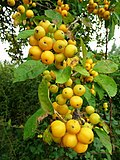The Malling series is a group of rootstocks for grafting apple trees. It was developed at the East Malling Research Station of the South-Eastern Agricultural College at Wye in Kent, England. From about 1912, Ronald Hatton and his colleagues rationalised, standardised and catalogued the various rootstocks in use in Europe at the time under names such as Doucin and Paradise. [1] [2] Their first list had nine rootstock varieties, assigned the "type" numbers I–IX. [3] The list later grew to twenty-four, and the Roman numerals gave way to Arabic numerals with the prefix "Malling" or "M.". [2] [3] From about 1917, collaboration between East Malling and the John Innes Institute, in Merton Park in Surrey, gave rise to the Malling-Merton series, which were resistant to Eriosoma lanigerum , the woolly apple aphid. [2]
Common Malling rootstocks in the 1940s:
- US M2, M7, M8, M9 and M13
- UK [4] M1, M2, M9, M12, M13 and M16.
- Germany [5] M1, M2, M4, M5, M9, M11 and M16.
Relative size are dependent on climate, variety and soil.
| Designation (Old designation) | Synonyms | Origin | Tree size a) | Tree size b) | Winter hardiness c) |
|---|---|---|---|---|---|
| M 1 (EM I) | Broad-leaved English paradise | England ca 1860 | v | sd-ss | 4 |
| M 2 (EM II) | Doucin | France | v | sd-ss | 4 |
| M 3 (EM III) | Dutch doucin, Hollyleaf paradise, Königs splittapfel | ? | sd | sd | 6 |
| M 4 (EM IV) | Holstein doucin, Yellow doucin | Unknown | sv | sd-ss | 5 |
| M 5 (EM V) | Doucin amelioré, Improved doucin, Red paradise | ? | v | sd-ss | 4 |
| M 6 (EM VI) | Nonsuch paradise, Rivers's paradise | England ca 1860 | sd | 2 | |
| M 7 (EM VII) | - | France, 1600s | sd | sd-d | 5 |
| M 8 (EM VIII) | French paradise | <1696 | d | d | 2 |
| M 9 (EM IX) | Jaune de metz, Yellow metz | France 1879 | vd | d | 3 |
| M 10 (EM X) | U 1 | ? | vv | ss-s | 2 |
| M 11 (EM XI) | Green doucin | Germany, 1904 | vv | ss | |
| M 12 (EM XII) | - | England | v | s | 4 |
| M 13 (EM XIII) | Black doucin, U 2 | Germany ca 1890 | v | sd-ss | 4 |
| M 14 (EM XIV) | U 5 | Germany | v | ss | |
| M 15 (EM XV) | U 6 | Germany | vv | ss-s | 2 |
| M 16 (EM XVI) | Ketziner ideal, U 3 | Germany ca 1909 | vv | ss-s | 5 |
| M 17 | identical to M 5 | Wageningen, Holland | sd | ||
| M 18 | - | Wageningen, Holland | v | ss | |
| M 19 | - | Berlin, Germany | v | ss | |
| M 20 | Spurious 9 | France ? | vd | sd-d | |
| M 21 | Cut-leaved 9 | ? | vd | sd-d | |
| M 22 | - | Chelmsford, England | v | ss | |
| M 23 | - | Chelmsford, England | v | sd | |
| M 24 | Paradis de menton, Noir de menton, | ? | v | ss |
a) East Malling vd= very dwarf, d= dwarf, sd= semidwarf, sv= semivigorous, v= vigorous, vv= very vigorous.
b) Tukey, Dwarfed fruit trees, 1964 d= dwarf, sd=semidwarf, ss= semistandard, s= standard.
c)Tukey, Dwarfed fruit trees, 1964 6= highest winter hardiness, 2= lowest winter hardiness.
| Name | Parentage | Cross made | Selected | Introduced |
|---|---|---|---|---|
| M 25 | Northern Spy x M 2 | 1952 | ||
| M 26 | M 16 x M 9 | 1929 | 1958 or 1959 | |
| M 27 | M 13 x M 9 | 1929 | 1934 | 1975 |

